Sony Xperia Z vs Apple iPhone 5

Introduction
Now that we've extensively reviewed Sony's latest flagship, it's time for us to start comparing it to the best smartphones that are available today and see just how well it stacks up against the competition. The first tough guy that we're going to compare the Xperia Z against is Apple's finest – the iPhone 5. Both smarpthones are among the very best out there, so this is bound to be an interesting clash. Now, let's see how the Z is going to fare against the status symbol!
Design
We rarely have the pleasure of comparing two smartphones that are both outstanding in terms of appearance and construction. This is one of those rare occasions, though, so things are going to get quite interesting. Both handsets look spectacularly-well, so it will be up to you to decide which one you like better.
The Xperia Z has an all-glass design, similar to the iPhone 4 and 4S. As a result that handset is very seductive – much better-looking than what it would have been if it had a simple soft-touch plastic back. Sony really deserves credit here for going this way. In addition, both the front and back panels are perfectly flat making for a very clean and stylish appearance.
Meanwhile, the iPhone 5 has replaced the all-glass back panel of its predecessors with a dark-gray aluminum one, surrounded by two smaller pieces of glass from above and below.
It's also worth mentioning that the iPhone 5 is much lighter and smaller than the Z, so people who do not enjoy very big phones should keep this in mind.
Sony has actually taken both the customers and the competition by surprise by giving the Xperia Z some rugged features. The Z is IP57 certified, meaning that it's dust- and water-resistant – something that no competing high-end smartphone can offer, including the iPhone 5.
Display
Aside from the obvious difference that the 5” display of the Xperia Z is much bigger than the 4” display of the iPhone 5, the Xperia Z has the advantage of the higher resolution – after all, it's a 1080p display that delivers a super-high pixel density of 441 ppi, compared to the iPhone 5's 326 ppi. Both pixel densities are extremely high and offer an incredibly crisp and clear image, with the Z naturally being a tad clearer.
In addition, the Xperia Z's viewing angles are quite poor – the overall image quality tends to degrade quickly as you start tilting the phone. Of course, some quality degradation is also visible with the iPhone 5, but to a much smaller extent.
Now that we've extensively reviewed Sony's latest flagship, it's time for us to start comparing it to the best smartphones that are available today and see just how well it stacks up against the competition. The first tough guy that we're going to compare the Xperia Z against is Apple's finest – the iPhone 5. Both smarpthones are among the very best out there, so this is bound to be an interesting clash. Now, let's see how the Z is going to fare against the status symbol!
We rarely have the pleasure of comparing two smartphones that are both outstanding in terms of appearance and construction. This is one of those rare occasions, though, so things are going to get quite interesting. Both handsets look spectacularly-well, so it will be up to you to decide which one you like better.
Sony has actually taken both the customers and the competition by surprise by giving the Xperia Z some rugged features. The Z is IP57 certified, meaning that it's dust- and water-resistant – something that no competing high-end smartphone can offer, including the iPhone 5.
Display
Aside from the obvious difference that the 5” display of the Xperia Z is much bigger than the 4” display of the iPhone 5, the Xperia Z has the advantage of the higher resolution – after all, it's a 1080p display that delivers a super-high pixel density of 441 ppi, compared to the iPhone 5's 326 ppi. Both pixel densities are extremely high and offer an incredibly crisp and clear image, with the Z naturally being a tad clearer.
However, when it comes to pure image quality, we actually find the iPhone to be superior. The displays of both phones are almost equally bright (the iPhone 5 has just a slight advantage there), but the Xperia Z's screen has a significantly lower contrast, and slightly less saturated colors, making it appear a bit washed out and not as vibrant as the iPhone 5's. Sure, the Xperia Z features the Mobile BRAVIA 2 engine, but that enhancement simply makes up for the difference between the two phones when you're viewing photos or watching video in the gallery. Do not expect it to blow the iPhone 5 out of the water.
In addition, the Xperia Z's viewing angles are quite poor – the overall image quality tends to degrade quickly as you start tilting the phone. Of course, some quality degradation is also visible with the iPhone 5, but to a much smaller extent.
Interface and Functionality
Sony has done a really good job streamlining the Android user interface and making it a bit more simple to use. That said, Android is Android, which means that it simply has way more options and settings for the user to play with than the iPhone's iOS 6. The choice when it comes to the user experience delivered by both platforms is a pretty simple one: If you want a device which you can tweak and customize to your liking, then you should get the Xperia Z. However, if you want a device that is really easy to use, then make no mistake about it – the iPhone 5 has the much more straightforward experience. Heavy multitaskers will enjoy the support for widgets and small apps in the Xperia Z, but casual users will appreciate the simplistic layout and lengthy battery life of the iPhone 5. In the end, neither experience is better, you just have to decide which one suits your usage style better.
Thanks to its bigger screen, the Xperia Z has the upper hand as far typing on the on-screen keyboard goes. Naturally, both the portrait and landscape keyboards are much more spacious on Sony's device, which can make the life of heavy texters that much easier.
Processor and Memory
Of course, there's not much use in comparing the hardware of smartphones that are running different operating systems, but we'll still do so for all the silicon aficionados out there.
Specs-wise, the Xperia Z is the more impressive handset, as it features a powerful quad-core processor – the Snapdragon S4 Pro, clocked at 1.5 GHz. The CPU is accompanied by the Adreno 320 GPU, which is also quite powerful, and together, this hardware can easily perform even the most demanding tasks with ease.
Meanwhile, the iPhone 5 is equipped with the dual-core A6 SoC, clocked at 1.3 GHz. The GPU is the powerful PowerVR SGX543MP3. As you can imagine, this combo is also capable of running every app incredibly smoothly, without a hint of lag.
The Sony Xperia Z comes with 16 GB of internal storage, but it also features a microSD card slot, allowing you to easily expand its storage space if need be. In contrast, the Apple iPhone 5 is offered in 16, 32 or 64 GB flavors, with no microSD support.
Internet and Connectivity
Internet browsing is a very important area, because one of the coolest and most frequently used features of a smartphone is the browser.
With Jelly Bean, Google decided to remove the stock browser from Android 4.0 ICS and replace it with mobile Chrome. There are good and bad sides to this. Among the things that Chrome does better are the double-tap zooming, the artificial font size increase of the important text areas, and the tabs. On the other hand, it's has a bit more lag and lacks Flash Player support. If having to use multiple browsers for different stuff doesn't bother you, though, this can be remedied by installing an additional, third-party browser and side-loading the Flash Player plug-in from Adobe's site.
A bit less flexible is the trusty Safari browser found on the iPhone 5. It also doesn't allow you to install the Flash Player, though you can get partial Flash support by installing some of the third-party browsers available. Still, lag is pretty much non-existent, and browsing feels tight, fun and satisfying. In the end, both handsets are great for browsing the web, with the Xperia Z being a bit more versatile, and the iPhone 5 being a bit more precise in terms of navigation.
Both the Xperia Z and iPhone 5 feature LTE and high-speed HSPA+ connectivity for up to 42.2 Mbit/s download speed. In addition, they both have Bluetooth 4.0 and support all the Wi-Fi profiles including 'n' on the 5GHz band, but only the Xperia Z has NFC.
Sony has done a really good job streamlining the Android user interface and making it a bit more simple to use. That said, Android is Android, which means that it simply has way more options and settings for the user to play with than the iPhone's iOS 6. The choice when it comes to the user experience delivered by both platforms is a pretty simple one: If you want a device which you can tweak and customize to your liking, then you should get the Xperia Z. However, if you want a device that is really easy to use, then make no mistake about it – the iPhone 5 has the much more straightforward experience. Heavy multitaskers will enjoy the support for widgets and small apps in the Xperia Z, but casual users will appreciate the simplistic layout and lengthy battery life of the iPhone 5. In the end, neither experience is better, you just have to decide which one suits your usage style better.
Thanks to its bigger screen, the Xperia Z has the upper hand as far typing on the on-screen keyboard goes. Naturally, both the portrait and landscape keyboards are much more spacious on Sony's device, which can make the life of heavy texters that much easier.
Processor and Memory
Of course, there's not much use in comparing the hardware of smartphones that are running different operating systems, but we'll still do so for all the silicon aficionados out there.
Specs-wise, the Xperia Z is the more impressive handset, as it features a powerful quad-core processor – the Snapdragon S4 Pro, clocked at 1.5 GHz. The CPU is accompanied by the Adreno 320 GPU, which is also quite powerful, and together, this hardware can easily perform even the most demanding tasks with ease.
The Sony Xperia Z comes with 16 GB of internal storage, but it also features a microSD card slot, allowing you to easily expand its storage space if need be. In contrast, the Apple iPhone 5 is offered in 16, 32 or 64 GB flavors, with no microSD support.
Internet and Connectivity
Internet browsing is a very important area, because one of the coolest and most frequently used features of a smartphone is the browser.
With Jelly Bean, Google decided to remove the stock browser from Android 4.0 ICS and replace it with mobile Chrome. There are good and bad sides to this. Among the things that Chrome does better are the double-tap zooming, the artificial font size increase of the important text areas, and the tabs. On the other hand, it's has a bit more lag and lacks Flash Player support. If having to use multiple browsers for different stuff doesn't bother you, though, this can be remedied by installing an additional, third-party browser and side-loading the Flash Player plug-in from Adobe's site.
A bit less flexible is the trusty Safari browser found on the iPhone 5. It also doesn't allow you to install the Flash Player, though you can get partial Flash support by installing some of the third-party browsers available. Still, lag is pretty much non-existent, and browsing feels tight, fun and satisfying. In the end, both handsets are great for browsing the web, with the Xperia Z being a bit more versatile, and the iPhone 5 being a bit more precise in terms of navigation.
Both the Xperia Z and iPhone 5 feature LTE and high-speed HSPA+ connectivity for up to 42.2 Mbit/s download speed. In addition, they both have Bluetooth 4.0 and support all the Wi-Fi profiles including 'n' on the 5GHz band, but only the Xperia Z has NFC.
Camera
Most of the things we've said about the general differences in the experience with both handsets are valid here as well. With the iPhone 5, you are getting a simple and clean camera app with as few options as possible. What this means is that users cannot try and tweak any settings in order to get the most of the scene before them, but their shots will also have a good base quality level below which it would be hard to fall. Meanwhile, the Xperia Z offers all the popular settings like ISO, metering, contrast level, exposure and many more. It also has some advanced features like a capable burst shot mode and HDR video recording, which may improve the quality a bit if you happen to be recording in low-light locations.
Even though the new Exmor RS sensor in the Xperia Z was much hyped, we ere actually disappointed to discover that the images taken with the Z were inferior to those taken with the iPhone 5 in almost all situations. Details are one area where the Xperia Z is especially disappointing, with everything looking muddy and unclear compared to the iPhone 5. On top of that, there's a noticeable purplish shade exhibited with the Xperia Z, which is quite unpleasant and makes for a colder and lifeless overall image. There problems are not observed with the pics of the iPhone 5, and while they aren't the most natural-looking either, they are significantly better as a whole.
Sony Xperia Z Sample Video:

Apple iPhone 5 Sample Video:

Multimedia
It goes without saying that the Sony Xperia Z is the more suitable phone for consuming multimedia like video and games. Thanks to its gigantic 5-inch screen, the experience is much more comfortable and easy on the eyes. The 4” display of the iPhone 5 is OK for a music video every now and then, but it isn't suited for longer activities.
Call quality
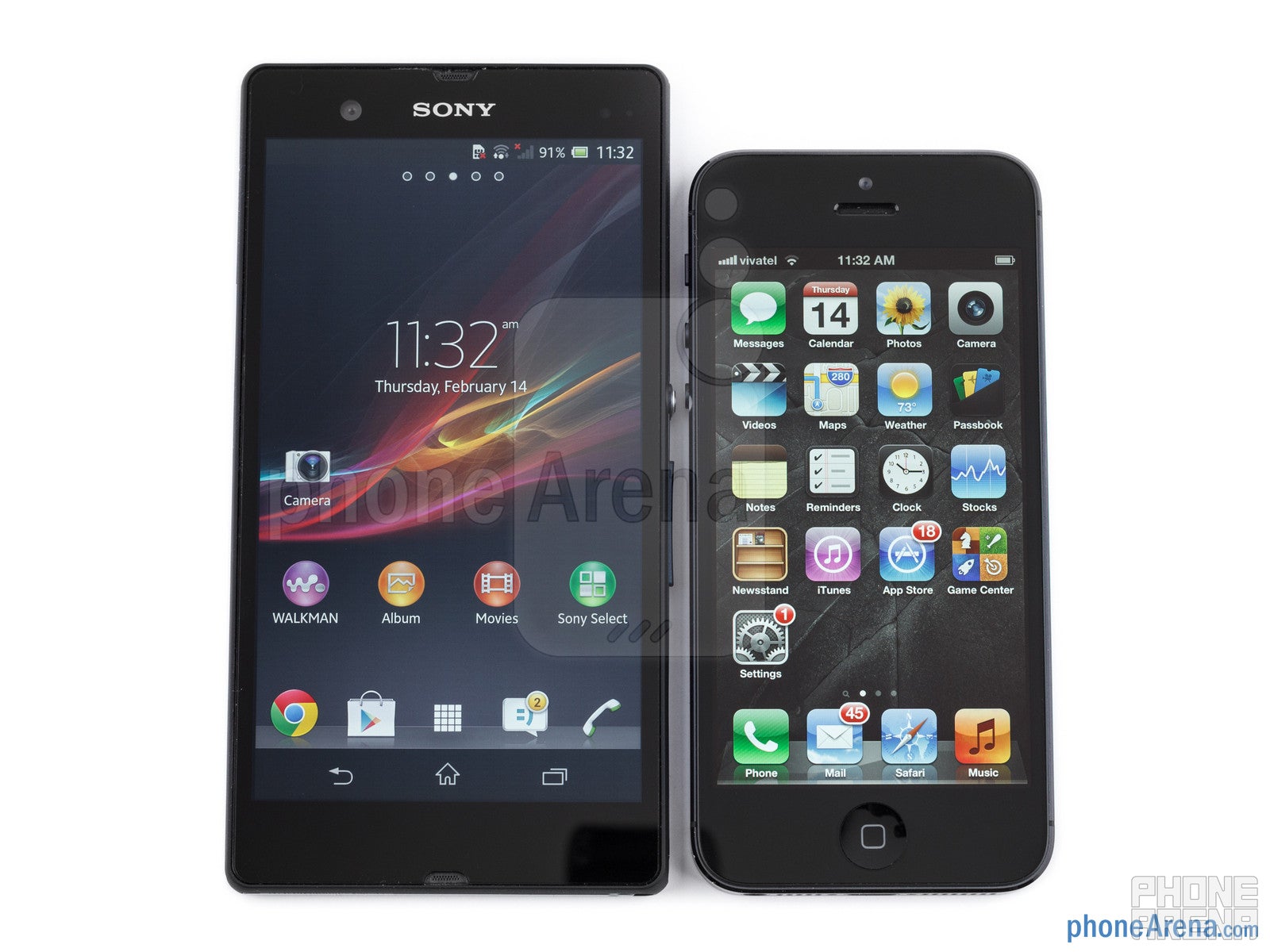
With such a big screen and Android, it would be quite unrealistic to expect the battery life of the Xperia Z to be as long as that of the iPhone 5. And you shouldn't! While the theoretical talk- and stand-by times are in favor of the Xperia Z: 14 hours talk-time and 22.1 days stand-by in 3G, versus the iPhone 5's 8 hours talk-time and 9.4 days stand-by, this shouldn't fool you into believing that Sony's handset can last longer, because these statistics do not take into account the power that's drawn by the screen and many other features, which will ultimately swing the pendulum back in favor of the iPhone 5. Of course, it's a ll a matter of choice, because what good is the iPhone 5's battery life if you want to enjoy your movies on a 5” display? Finally, if you do some smart power management, you should be able to get up to two days of use on a single charge with both handsets.
Conclusion
The Xperia Z is a truly impressive phone. It's one of hose few Android devices that manage to be exciting both on the inside and on the outside. It has some indisputable advantages over the iPhone 5 such as its way bigger screen and flexible operating system which allows the user to tweak the experience any way they want.
We should also note, however, that the amount of detail that Apple has paid to pretty much everything in the iPhone 5 is simply mind-boggling. All the aspects of the device have been tweaked with much care, resulting in an especially well-rounded smarpthone.
If a simple to use, reliable and capable handset is what you are after, iPhone 5 should be the way to go. On the other hand, if you desire a true multimedia powerhouse and something with more personalization options, the Xperia Z will be the better choice for you.

Follow us on Google News
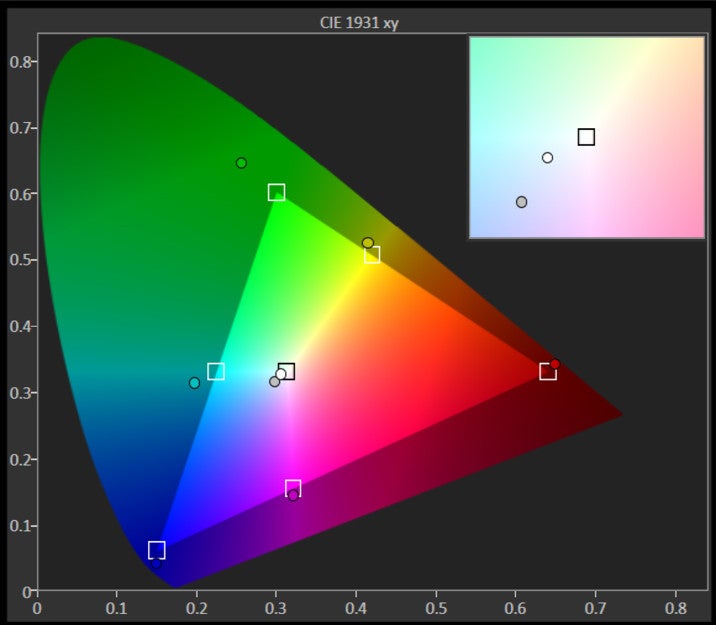









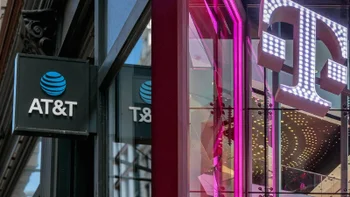

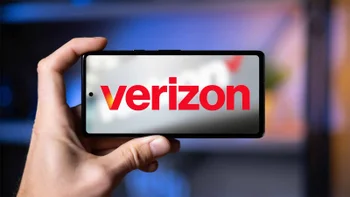






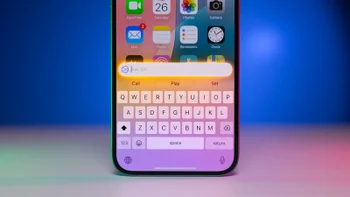
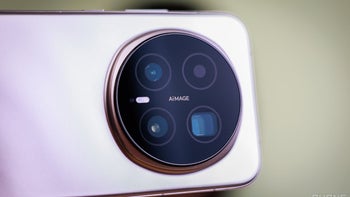
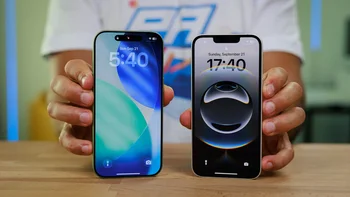

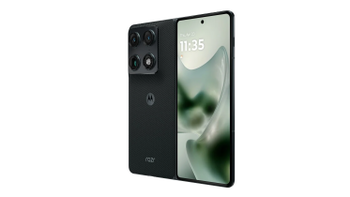
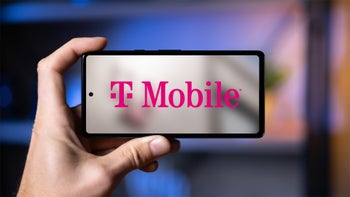
Things that are NOT allowed:
To help keep our community safe and free from spam, we apply temporary limits to newly created accounts: